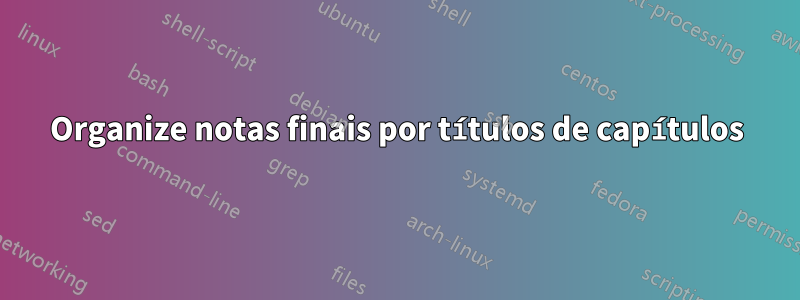
Estou tentando enotezorganizar ("dividir") minhas notas finais por capítulo e usar os títulos dos capítulos relevantes como títulos (de preferência centralizados), conforme demonstrado abaixo, e incluir a paginação à qual as notas se referem no cabeçalho (por exemplo,Notas para as páginas 25-37), usando titlesec.
Notes
CHAPTER I: TeX
1. TeX is a typesetting system (or a "formatting system").
2. TeX was designed and mostly written by Donald Knuth.
CHAPTER 2: WYSIWYG
1. *WYSIWYG* stands for What You See Is What You Get.
2. The phrase implies a user interface that allows the user to view something very similar to the end result.
3. *WYSIWYG* means that the display simulates the appearance and represents the effect of fonts and line breaks on the final pagination using a specific printer configuration.
O código até agora:
\documentclass[12pt, twoside, openright]{book}
\usepackage{blindtext}
\newcommand{\hsp}{\hspace{18pt}}
\usepackage[pagestyles]{titlesec}
\titleformat{\chapter}[hang]{\Huge\bfseries}{\thechapter\hsp}{0pt}{\Huge\bfseries}
\newpagestyle{main}{\sethead[\thepage][\textit{\thetitle}][] % even
{}{\textit{\chaptertitle}}{\thepage}} % odd
\pagestyle{main}
\usepackage{enotez}
\setenotez{backref=true, totoc, split=chapter, split-title={\MakeUppercase{\chaptername\ <ref>: <title>}}}
\NewSplitTitleTag{title}{\nameref{ch:<split-level-id>}}
\begin{document}
%frontmatter etc.
\mainmatter
\chapter{TeX}
When the second edition\endnote{TeX is a typesetting system (or a "formatting system").} was published, in 1976, the whole book had to be typeset again because the Monotype technology had been largely replaced by phototypesetting, and the original fonts were no longer available. When Knuth\endnote{TeX was designed and mostly written by Donald Knuth.} received the galley proofs of the new book on 30 March 1977, he found them inferior.
\chapter{WYSIWYG}
Modern software does a good job of optimizing the screen display for a particular type of output. For example, a word processor is optimized for output to a typical printer. The software often emulates the resolution of the printer in order to get as close as possible to WYSIWYG\endnote{WYSIWYG stands for What You See Is What You Get.}. However, that is not the main attraction of WYSIWYG\endnote{The phrase implies a user interface that allows the user to view something very similar to the end result.}, which is the ability of the user to be able to visualize what they are producing\endnote{WYSIWYG means that the display simulates the appearance and represents the effect of fonts and line breaks on the final pagination using a specific printer configuration}.
\backmatter
\cleardoublepage
\printendnotes
\addtocontents{toc}{\vspace{-0.5em}}
\end{document}
Responder1
Você poderia usar a memoirclasse (um superconjunto de classes de artigos de book,relatório and) com seus próprios recursos para notas finais. Abaixo modifiquei seu MWE para dar o que acho que você deseja.
% endnotesprob.tex SE 535808
%\documentclass[12pt, twoside, openright]{book}
\documentclass[12pt, twoside, openright]{memoir}
\makepagenote % for memoir's endnotes
\usepackage{comment}
\usepackage{blindtext}
\newcommand{\hsp}{\hspace{18pt}}
\usepackage[pagestyles]{titlesec}
\titleformat{\chapter}[hang]{\Huge\bfseries}{\thechapter\hsp}{0pt}{\Huge\bfseries}
\newpagestyle{main}{\sethead[\thepage][\textit{\thetitle}][] % even
{}{\textit{\chaptertitle}}{\thepage}} % odd
\pagestyle{main}
%%%%%%%%%%%%%%%%%%%%%%%%
\begin{comment}
\usepackage{enotez}
\setenotez{backref=true, totoc, split=chapter, split-title={\MakeUppercase{\chaptername\ <ref>: <title>}}}
\NewSplitTitleTag{title}{\nameref{ch:<split-level-id>}}
\end{comment}
%%%%%%%%%%%%%%%%%%%%%%%
\begin{document}
%frontmatter etc.
\mainmatter
\chapter{TeX}
When the second edition\pagenote{TeX is a typesetting system (or a "formatting system").} was published, in 1976, the whole book had to be typeset again because the Monotype technology had been largely replaced by phototypesetting, and the original fonts were no longer available. When Knuth\pagenote{TeX was designed and mostly written by Donald Knuth.} received the galley proofs of the new book on 30 March 1977, he found them inferior.
\chapter{WYSIWYG}
Modern software does a good job of optimizing the screen display for a particular type of output. For example, a word processor is optimized for output to a typical printer. The software often emulates the resolution of the printer in order to get as close as possible to WYSIWYG\pagenote{WYSIWYG stands for What You See Is What You Get.}. However, that is not the main attraction of WYSIWYG\pagenote{The phrase implies a user interface that allows the user to view something very similar to the end result.}, which is the ability of the user to be able to visualize what they are producing\pagenote{WYSIWYG means that the display simulates the appearance and represents the effect of fonts and line breaks on the final pagination using a specific printer configuration}.
\backmatter
\cleardoublepage
% \printendnotes
\printpagenotes % for memoir's endnotes
\addtocontents{toc}{\vspace{-0.5em}}
\end{document}
Para evitar conflitos com outros pacotes memoirusa a macro \pagenoteem vez \endnotede notas finais. No preâmbulo você deve colocar \makepagenotepara obter notas finais e usar \printpagenotesquando quiser imprimi-las. A texdoc memoirseção do manual ( )17.4 Notas finaisdescreve muitas maneiras de ajustar a aparência das notas finais tanto no texto principal quanto na listagem.




